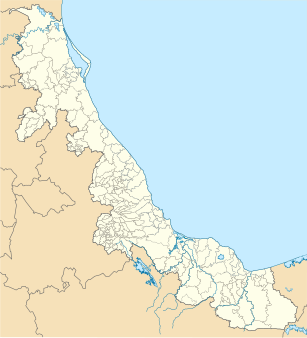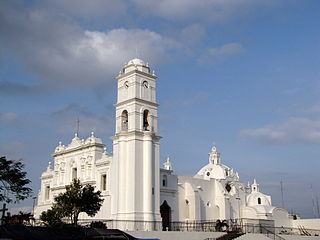
Veracruz, formally Veracruz de Ignacio de la Llave, officially the Free and Sovereign State of Veracruz de Ignacio de la Llave, is one of the 31 states which, along with Mexico City, comprise the 32 Federal Entities of Mexico. It is divided into 212 municipalities, and its capital city is Xalapa-Enríquez.

Xalapa or Jalapa, officially Xalapa-Enríquez, is the capital city of the Mexican state of Veracruz and the name of the surrounding municipality. In the 2005 census the city reported a population of 387,879 and the municipality of which it serves as municipal seat reported a population of 413,136. The municipality has an area of 118.45 km2. Xalapa lies near the geographic center of the state and is the second-largest city in the state after the city of Veracruz to the southeast.

The Totonac are an indigenous people of Mexico who reside in the states of Veracruz, Puebla, and Hidalgo. They are one of the possible builders of the pre-Columbian city of El Tajín, and further maintained quarters in Teotihuacán. Until the mid-19th century they were the world's main producers of vanilla.

Papantla is a city and municipality located in the north of the state of Veracruz, Mexico, in the Sierra Papanteca range and on the Gulf of Mexico. The city was founded in the 13th century by the Totonacs and has dominated the Totonacapan region of the state since then. This is the home of vanilla, which is native to this region, the Danza de los Voladores and the El Tajín archeological site, which was named a World Heritage Site. Papantla still has strong communities of Totonacs who maintain the culture and language. The city contains a number of large scale murals and sculptures done by native artist Teodoro Cano García, which honor the Totonac culture. The name Papantla is from Nahuatl and most often interpreted to mean "place of the papanes". This meaning is reflected in the municipality's coat of arms.

Misantla is a city in the Mexican state of Veracruz, the administrative seats of the municipality (municipio) of the same name. The municipality is bordered by Martínez de la Torre, Colipa and Papantla.

Poza Rica, formally: Poza Rica de Hidalgo is a city and its surrounding municipality in the Mexican state of Veracruz. Its name means "rich well/pond". It is often thought that the name came to be because it was a place known for its abundance of oil. In reality, before oil was discovered, there existed a pond rich in fish, which gave origin to the city’s name. In the last century oil was discovered in the area. It has since been almost completely extracted. This has resulted in the decline of oil well exploration and drilling activities, though there are still many oil facilities.

Totonacapan refers to the historical extension where the Totonac people of Mexico dominated, as well as to a region in the modern states of Veracruz and Puebla. The historical territory was much larger than the currently named region, extending from the
The Totonacan languages are a family of closely related languages spoken by approximately 290,000 Totonac and Tepehua people in the states of Veracruz, Puebla, and Hidalgo in Mexico. At the time of the Spanish conquest Totonacan languages were spoken all along the gulf coast of Mexico. During the colonial period, Totonacan languages were occasionally written and at least one grammar was produced. In the 20th century the number of speakers of most varieties have dwindled as indigenous identity increasingly became stigmatized encouraging speakers to adopt Spanish as their main language.

The Danza de los Voladores, or Palo Volador, is an ancient Mesoamerican ceremony/ritual still performed today, albeit in modified form, in isolated pockets in Mexico. It is believed to have originated with the Nahua, Huastec and Otomi peoples in central Mexico, and then spread throughout most of Mesoamerica. The ritual consists of dance and the climbing of a 30-meter pole from which four of the five participants then launch themselves tied with ropes to descend to the ground. The fifth remains on top of the pole, dancing and playing a flute and drum. According to one myth, the ritual was created to ask the gods to end a severe drought. Although the ritual did not originate with the Totonac people, today it is strongly associated with them, especially those in and around Papantla in the Mexican state of Veracruz. The ceremony was named an Intangible cultural heritage by UNESCO in order to help the ritual survive and thrive in the modern world. The Aztecs believed that Danza de los Voladores was the symbol of their culture.

Universidad Veracruzana is a public autonomous university located in the Mexican state of Veracruz. Established in 1944, the university is one of the most important in the southeast region of México. Its academic organization is a structure based on academic areas, schools, education programs and research institutes. Due to geographic dispersing, academic activities are coordinated by the Academic Secretariat and four Vice-Rector's Offices. General Directions of the academic areas: Arts, Biology and Agricultural Sciences, Health Sciences, Economics and Business Administration, Liberal Arts and Technical coordinate as well each school and educational programs. The Department of Research coordinates the plans and activities of the research institutes, and the Direction of Art Dissemination operates the artistic groups and the cultural activities programs.

El Zapotal is a Totonac archaeological site located in the Ignacio de la Llave Municipality in Veracruz, Mexico. It contains the ruins of a Totonac city that flourished from 600 to 900 CE, during what archaeologists call the Classical Period.

Melchor Peredo is a Mexican muralist and a representative of the social realist school of mural painting in Mexico. His murals depict historical scenes from Mexican history with an emphasis on revolutionary subjects. His work is featured in public and government buildings across Mexico. He has also painted murals in the USA and Europe. He lives in Xalapa, Veracruz.
Alberto Beltrán García was a Mexican graphic artist and painter known principally for his work with publications such as illustrations and political cartoons but he created a number of murals as well. He was born in the rough neighborhood of Tepito and began drawing for local publishers when he was a teenager. He attended the Escuela Nacional de Artes Plásticas where one of his teachers introduced him to the Taller de Gráfica Popular where he began his career in earnest. From the late 1940s until his death, he work with various publications, mostly newspapers, but he also did book illustrations as well. In his later career, he worked on a number of murals, especially in the state of Veracruz, which he had an affinity for. Despite winning a number of important awards for his work, he is relatively unknown even in Mexico, with collections of his work scattered among a number of institutions.

The cuisine of Veracruz is the regional cooking centered on the Mexican state that stretches over most of the country's coast on the Gulf of Mexico. Its cooking is characterized by three main influences, indigenous, Spanish and Afro-Cuban, due to its history, which included the arrival of the Spanish and that of slaves from Africa and the Caribbean. These influences have contributed many ingredients to the cooking including native vanilla, corn and seafood, along with rice, spices and tubers. How much the three mix depending on the area of the state, with some areas more heavily favoring one or another. The state has worked to promote its cuisine both in Mexico and abroad as part of its tourism industry.
Mario Orozco Rivera was a Mexican muralist and painter, a later proponent of Mexican muralism, and whose work was particularly influenced by David Alfaro Siqueiros. He created a number of murals, mostly in the state of Veracruz before becoming an assistant to Siqueiros, directing the Taller Siqueiros in Cuernavaca and working with the artists on projects such as the Polyforum Cultural Siqueiros. While preferring mural work, which he considered less commercial, Orozco Rivera also created oils and sculptures. Many of these works were exhibited in Mexico and abroad and can be found in many major collections. His work received recognition in various countries.

XEPR-AM and XHPR-FM in Poza Rica, Veracruz is an AM/FM combo radio station broadcasting on 1020 kHz and 102.7 MHz.

Francisco de Paula Milán was an officier of the Mexican Army from the Liberals group, that fought in the service of Benito Juárez.
Marco Tulio Aguilera Garramuño is a Colombian novelist, critic and journalist. Born in Bogota, he studied philosophy at the Universidad del Valle and literature at the University of Kansas. Since then, he has lived in Costa Rica and México, where he has taught at the Universidad Veracruzana.

The Totonac culture or Totonec culture was a culture that existed among the indigenous Mesoamerican Totonac people who lived mainly in Veracruz and northern Puebla. Originally, they formed a confederation of cities, but, in later times, it seems that they were organized in three dominions: North, South and Serran. Its economy was agricultural and commercial. They had large urban centers such as: El Tajín (300–1200), which represents the height of the Totonac culture, Papantla (900–1519) and Cempoala (900–1519).















